Yakushima: A Land of Rain, Forest, and Myth

Yakushima, a remote, mountainous island in Kagoshima Prefecture, lies just off the southern coast of Kyushu. Famed for its lush, ancient cedar forests and intense rainfall, Yakushima is a place where nature takes center stage in its most dramatic form. Locals claim it rains “35 days a month,” and they’re only half joking. With annual precipitation reaching up to 10,000 mm in some areas, it’s one of the wettest places on Earth.
This relentless rain breathes life into the island’s moss-covered landscapes, creating a mystical forest shrouded in fog and dripping with atmosphere. The saturated climate supports Yakusugi—ancient Japanese cedar trees, many over a thousand years old—and gives the island an otherworldly appearance that’s inspired everything from poetry to pop culture.
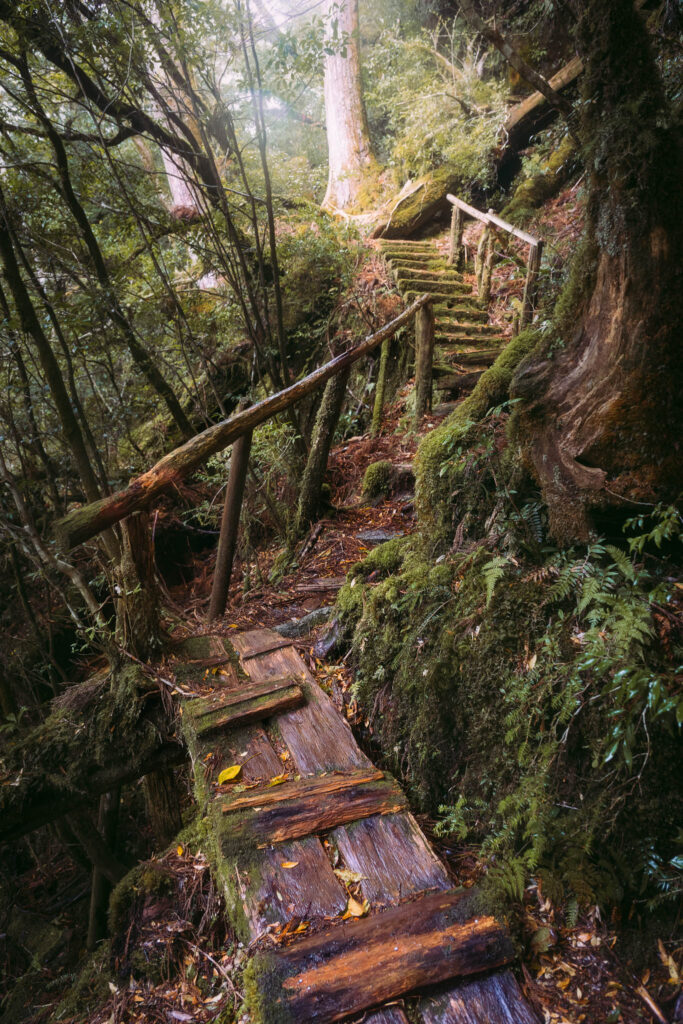
The Ghibli Connection and Yakusugi Lore
If the forests of Yakushima seem like something out of a fantasy film, that’s because they are. The island famously inspired the enchanted setting of Princess Mononoke, Studio Ghibli’s 1997 masterpiece. The spirits of the forest, the mossy trunks, and the primal beauty of the land are all deeply rooted in Yakushima’s real-world ecology.
Yakusugi, the term for cedar trees older than 1,000 years, are the crown jewels of the island’s forest. These trees, including the revered Jōmon Sugi—believed to be over 2,000 years old—stand as ancient guardians in the damp woods. Their gnarled forms and thick bark seem to tell the story of millennia. Recognizing this ecological wonder, UNESCO designated Yakushima Japan’s first World Natural Heritage Site in 1993.

Getting to Yakushima
After hearing so much about Yakushima—the endless rain, ancient forests, and the Ghibli-like atmosphere—I knew I had to see it for myself. Since I was already in nearby Miyazaki in April, I decided to tack on a short trip and go explore the island with my camera.
Getting there, however, didn’t go quite to plan.
I made my way to the city of Kagoshima first—a place that’s actually worth spending more time in on its own—planning to take the slow car ferry to Yakushima. It’s the cheapest option at around 5,000–6,000 yen one way, takes about 4 hours, and leaves from Taniyama Port. I wasn’t in a rush, so it seemed like a good idea. But when I arrived at the terminal at 7 a.m.—soaked from walking through the rain—I found the building completely empty. One small sign on the window: “Today’s crossing cancelled.”
No staff, no announcements, just silence and drizzle. Great.
I thought the high-speed jetfoil ferry had to be booked in advance, but I figured I might as well check. I found the Yakushima2 High-Speed Ferry Terminal on the map—thankfully only a few minutes away—and walked there in the rain, getting even wetter. This terminal was full of life. I went to the counter and asked if any boats were available. Luckily, there was one leaving in five minutes.
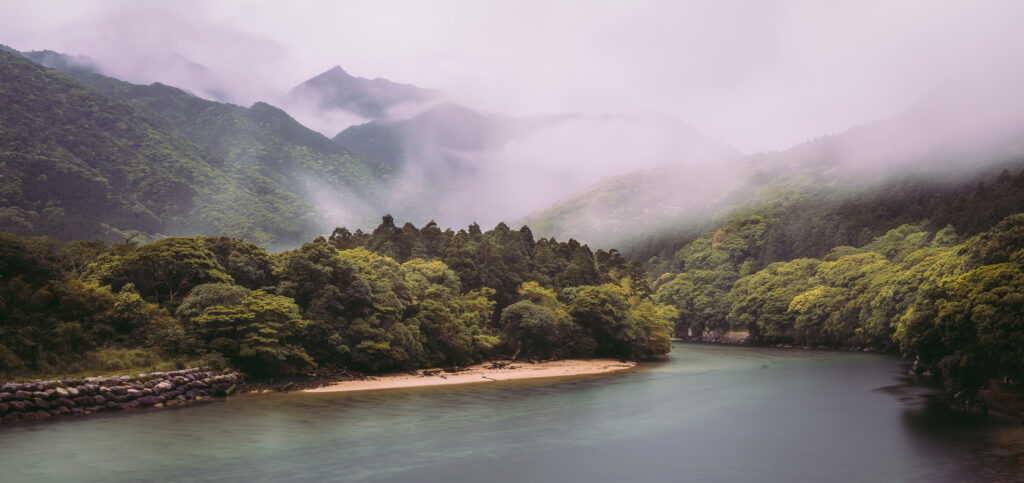
I grabbed a ticket, slightly annoyed at now paying 12,000 yen—more than double the price of the slow ferry—but relieved to be going anywhere. The jetfoil is much faster, taking only 2 hours, and runs multiple times daily from Kagoshima Honko Port to either Miyanoura or Anbo Port on Yakushima.
I arrived at Miyanoura Port around 9:30 a.m.—far too early for check-in at my guesthouse, and my rental car wasn’t available until 3 p.m. The rain was still coming down, so I found a nearby café, ordered a long coffee, and waited it out.
By early afternoon, the weather finally cleared. I picked up my car, had a quick look around the sleepy town of Miyanoura (the island’s main hub), then set off toward my first destination: sunset at Inakahama Beach.
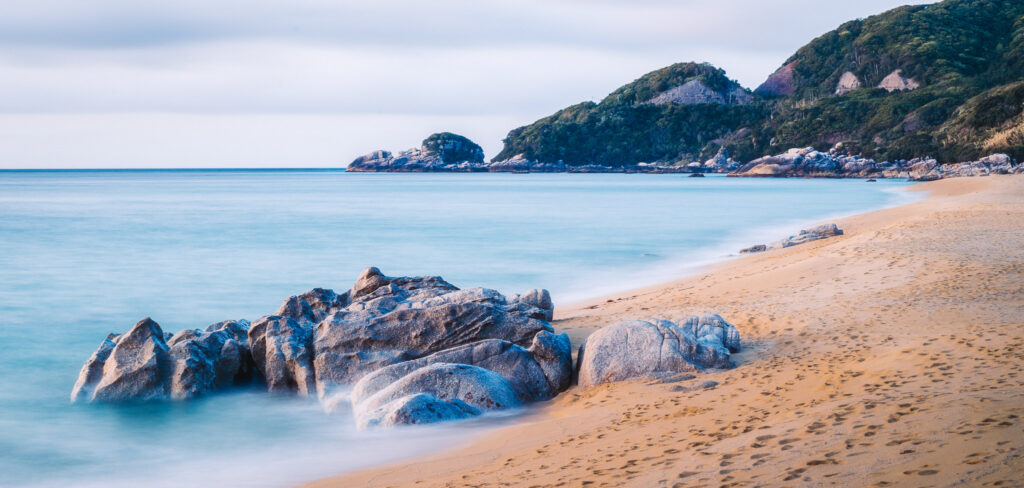
Inakahama Beach at Sunset
Inakahama Beach is a stunning stretch of golden sand with a tropical feel. When I arrived, the ocean was calm, the skies had finally cleared, and it felt like the trip was about to begin properly. Apparently, sea turtles come here to nest at certain times of the year—which would be incredible to see—but not in April.
With time to kill before sunset, I wandered up and down the beach scouting compositions. Eventually, I found a spot with green, seaweed-covered rocks and set up my tripod. The sun was starting to drop behind a small offshore island, and I used the cracks and tidal pools in the rocks as leading lines to guide the eye through the scene. There was another cluster of rocks in the midground that felt a bit messy, though, so I made a mental note to try editing them out later and see if the image felt stronger without them.

I kept shooting as the light changed—once when the sun was still hitting the top of the island, and again after it disappeared behind it. In the end, I preferred the photos from just before the sun vanished, with a single cloud hanging right above the island adding a little drama. I still can’t decide whether those midground rocks ruin the composition or add depth, so I edited two versions and might still go back and forth.
As I was about to head back, I noticed another group of rocks catching the last of the light further down the beach. I quickly grabbed a few more frames, using the rocks as foreground to help balance out the headland in the background. One thing that did annoy me, though, was all the footprints in the sand. By that point in the day, the beach had been well-trafficked and there was no avoiding them—so I just worked with what I had and focused on light and framing.
With the sun gone, I stretched the exposures longer to soften the ocean and get that slow, dreamy look. It was a quiet and peaceful way to end the day—exactly the kind of scene I’d hoped for.
Shiratani Unsuikyo Ravine
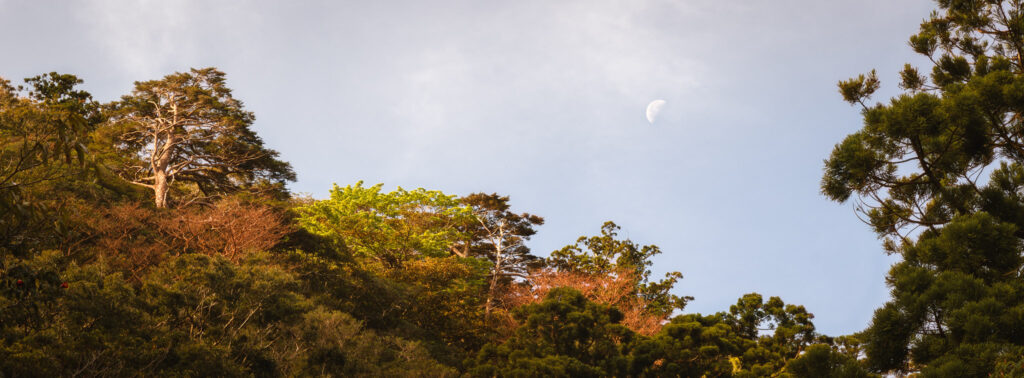
The next morning, I headed to Shiratani Unsuikyo Ravine, one of Yakushima’s most iconic forest areas. It’s especially well-known for its ancient Yakusugi—massive Japanese cedar trees that are over 1,000 years old—along with moss-covered roots, twisting branches, and a mysterious, enchanted feel that inspired the forest in Princess Mononoke.
There are several trails to choose from, ranging from easy 30-minute loops to longer 4-hour hikes. I’d heard that the most photogenic Yakusugi trees and mossy scenes were along the medium-length course, about 2 hours return, so that’s the one I aimed for. I arrived relatively early, hoping to beat the crowds and catch some nice soft morning light.
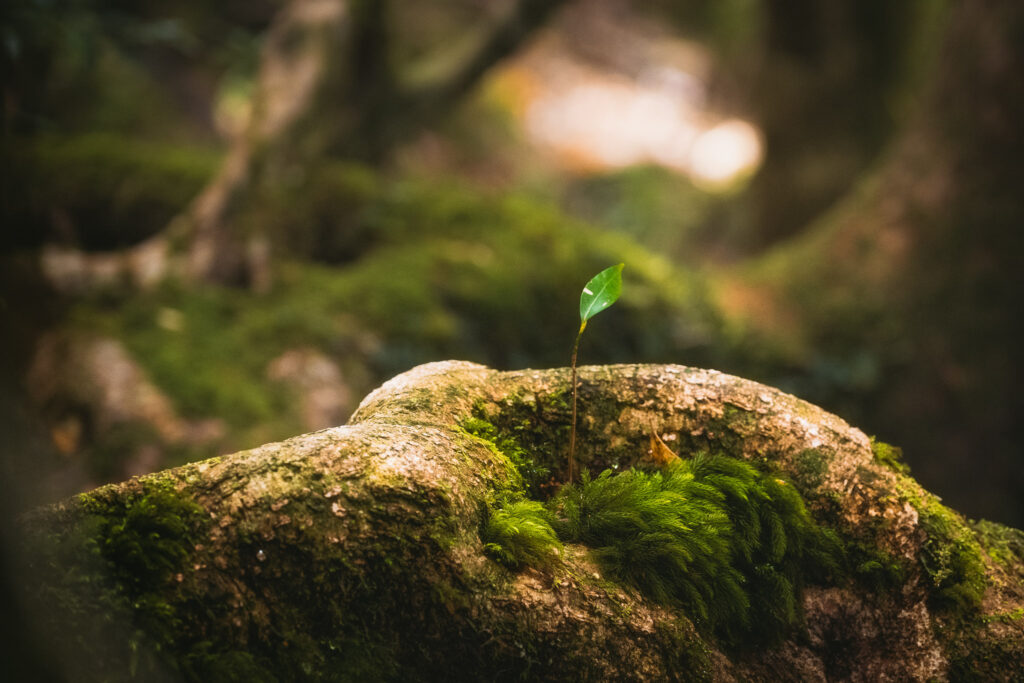
At first, the conditions seemed promising—but despite the forecast calling for clouds, it turned into a blue-sky day. The sun rose quickly, and the light got harsh fast. With deep shadows and bright highlights everywhere, it became difficult to photograph wide forest scenes in a way that looked good. So I shifted focus and started looking for smaller details—patches of moss, root patterns, and bits of texture where I could control the light better.
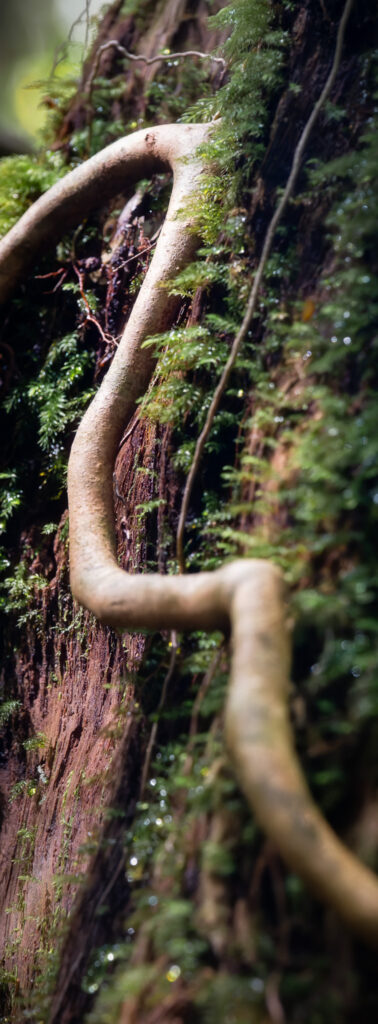
A bit further in, I ran into a trail closure that blocked access to the course I had planned. I had no choice but to follow a shorter loop instead. The forest was still beautiful, and I passed a few Yakusugi trees, but none of them really grabbed me enough to stop and set up the tripod in the harsh light.
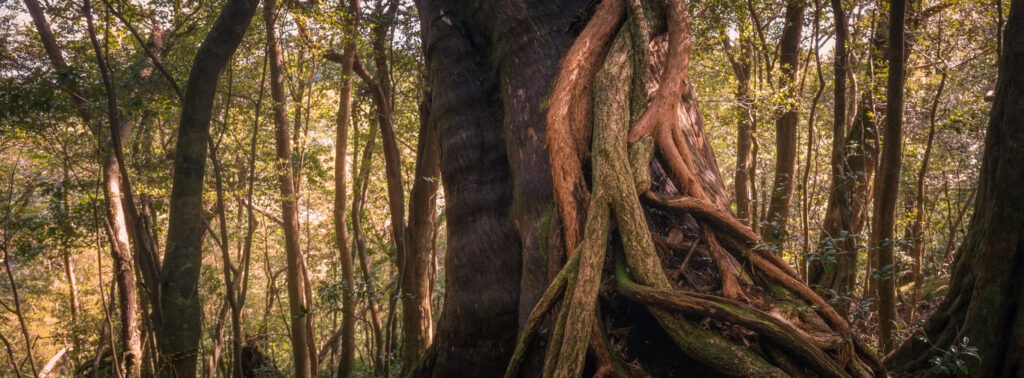
Eventually, I found the entrance to another trail and decided to follow it for a bit to see if things improved. The forest higher up was more scenic, and I managed to get a few shots I liked. But as more people started arriving and the trail got busier, the peaceful mood started to fade, so I turned back and decided to explore somewhere quieter.
Looping the Island
With the light turning harsh and the trails at Shiratani starting to fill up, I decided to change plans and explore more of the island by car. I’d read that the Seibu Rindo Wildlife Road—a narrow stretch through deep forest on the island’s remote western side—was best in the late afternoon, when the light is softer and the wildlife more active.
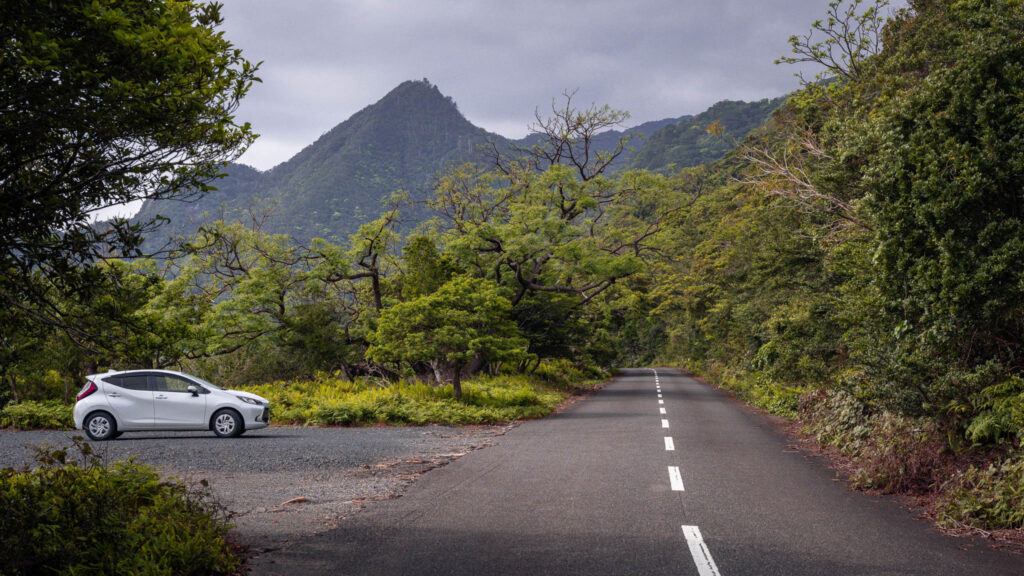
So I made a loop around Yakushima’s coastal road, checking out a few interesting spots along the way and stopping anywhere that looked promising. It gave me a better feel for the island’s variety—and turned out to be a great way to break up the day while waiting for the right conditions.
Side Stops on the Island Loop: Banyan Tree & Senpiro Falls
While driving, I spotted a pin on Google Maps marking a banyan tree just off the main road. Curious, I turned off and followed a narrow road to a small car park, where a faint trail disappeared into the forest. A short walk in, and I found it—or rather, became surrounded by it. The banyan wasn’t a single towering trunk, but a sprawling tangle of vines, roots, and branches twisting out in every direction. It was hard to tell where the tree began or ended. There was no way to step back far enough to capture the full scale of it, so I focused on abstract detail shots, picking out pieces of texture and form to simplify the chaos. The images don’t quite show how huge or wild it felt in person, but it was an awesome spot to stumble across.

Later on, I made a quick stop at Senpiro Falls, one of Yakushima’s best-known waterfalls. The viewpoint is easy to access, but there’s really only one main platform, so most photos from there tend to look the same. Still, it’s a dramatic waterfall dropping into a massive granite bowl, and worth seeing if you’re nearby.
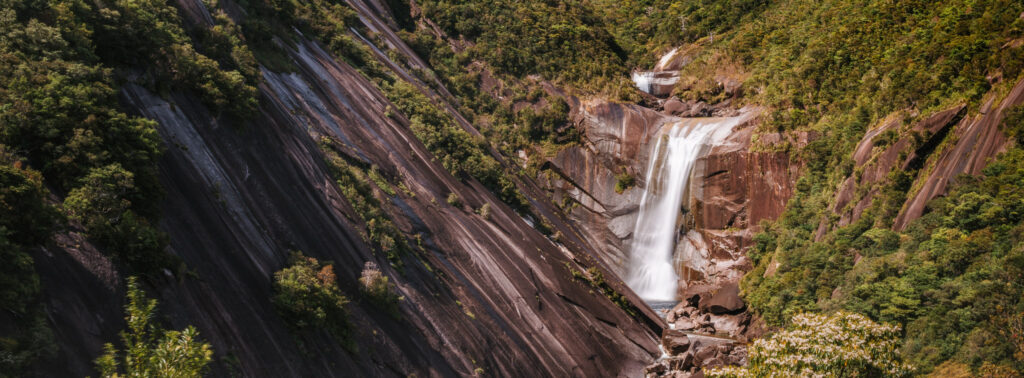
As I walked back to the car, I noticed some movement in the trees to my left. A group of Yaku monkeys was foraging in the canopy. I quickly switched over to my Nikon 300mm f/4 PF on the Z8 and managed to capture one of my favorite shots from the whole trip—a monkey lit just right, peeking upward through a dark patch of forest. The light hit its face perfectly. A fleeting moment, but one that made the stop unexpectedly special.
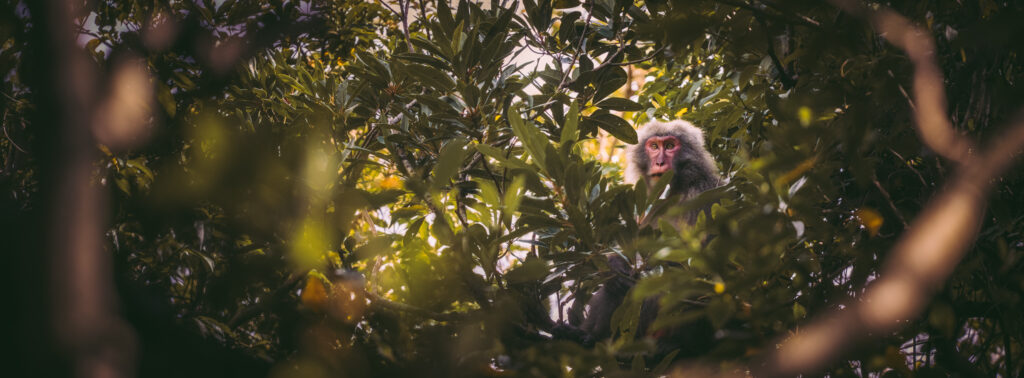
Wild Encounters on Yakushima’s Wildlife Road
From there, I continued on to the Seibu Rindo Forest Path, often just called the Wildlife Road. This narrow, winding road cuts through one of the island’s most untouched areas, hugging the coastline with dense jungle on one side and steep drops to the sea on the other. It’s well known for the Yaku monkeys and Yakushima Sika deer that freely roam through the forest—and often right onto the road.
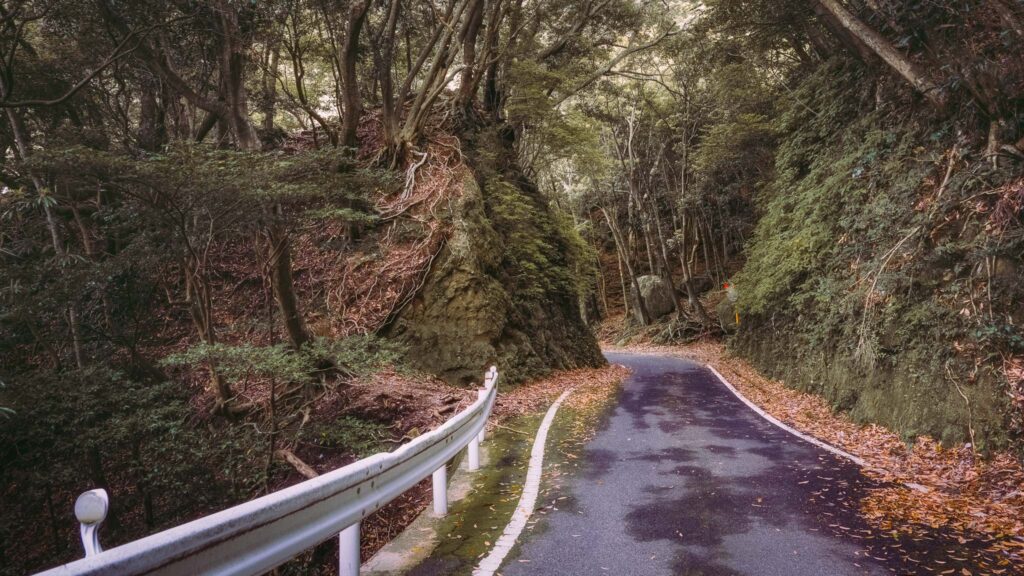
It didn’t take long to spot the first group of deer grazing by the roadside. They were Yakushika, a subspecies of Japanese Sika deer that’s native to the island. I was surprised at how small and delicate they looked compared to the much larger Sika deer I see in Hokkaido. These ones had shorter legs, more compact bodies, and seemed generally more relaxed around people and cars.
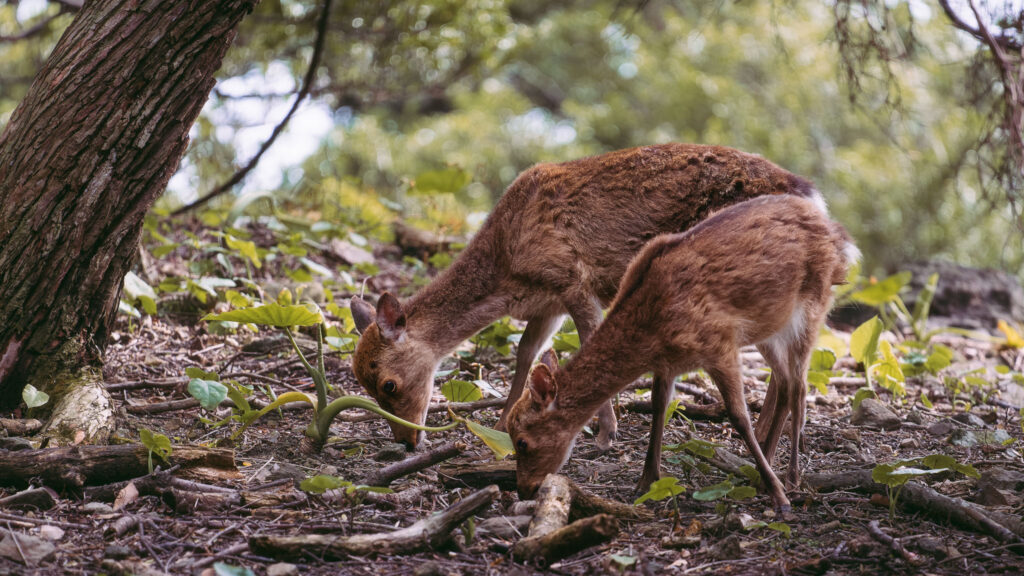
A little further along, I stepped off the road for a bit and managed to get a few decent shots. Then I spotted a larger macaque sitting close by. These Yaku monkeys are a subspecies of Japanese macaque found only on Yakushima. They’re shorter and stockier than their mainland relatives, with thicker fur that helps them deal with the island’s constant dampness and cooler mountain climate.
I hadn’t realized how close I’d gotten until we locked eyes. He clearly wasn’t happy about it.
Instead of backing off, I instinctively raised my camera—and that’s when he charged.
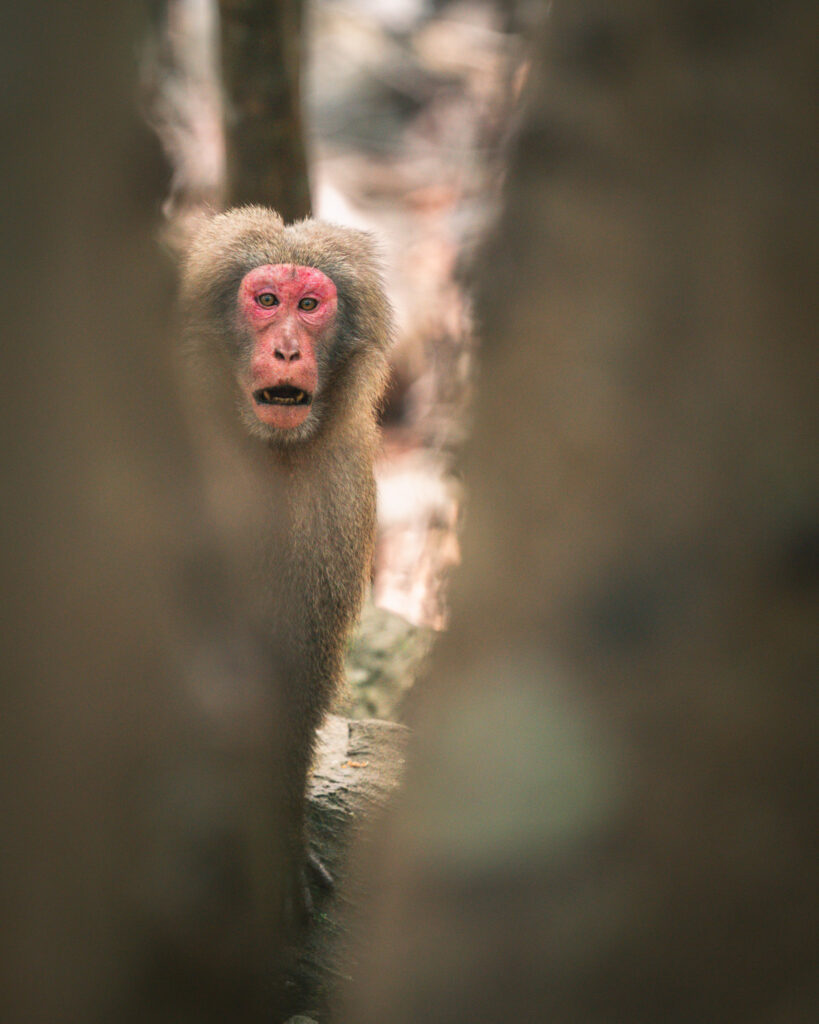
I bolted. He wasn’t seriously trying to hurt me and stopped almost immediately, but it was still a pretty clear message: I was way too close, and he wasn’t in the mood for portraits. A good reminder that while the wildlife here is used to people, they’re definitely not tame—and they don’t appreciate being stared at.
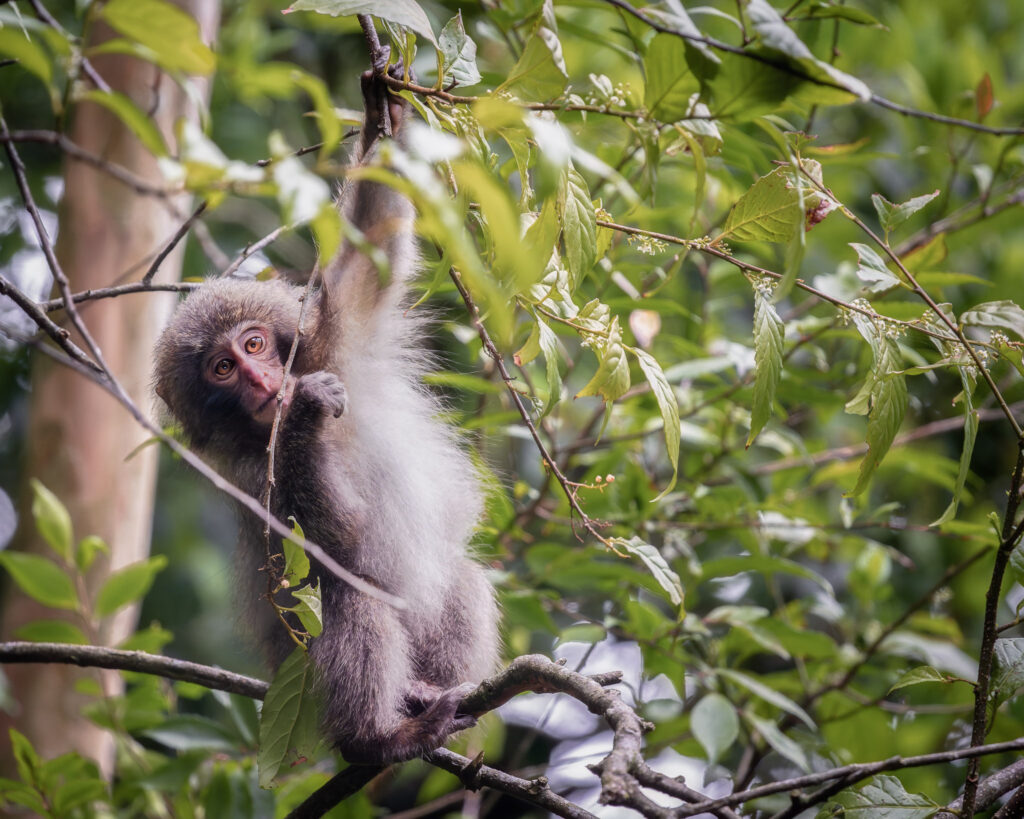
I carried on down the road, which soon narrowed into a single-lane track winding through dense forest, with monkeys and deer often sitting right in the middle of it. They barely moved for cars, only shifting aside at the last moment. If you’re planning to drive this route, take it slow—especially around corners. There’s a high chance you’ll come face to face with something furry blocking your way.
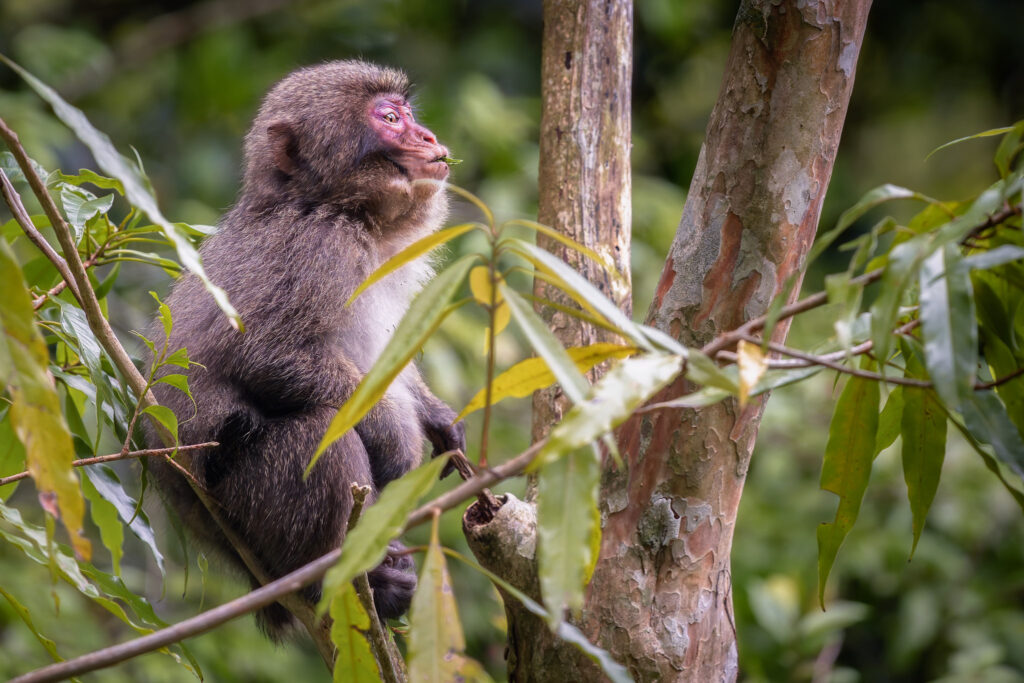
Throughout the drive, I kept stopping to shoot more wildlife. For most of these photos, I used the Nikon 300mm f/4 PF paired with my Z8. I shot in manual mode with Auto ISO, keeping my shutter speed at 1/800 or faster to freeze movement in the dim forest light. I mostly stayed at f/4 to let in as much light as possible, and the 300mm PF held up really well—plenty sharp even wide open. For closer encounters or when I wanted to include more of the environment, I swapped to the Z 24–120mm f/4, which gave me more flexibility.
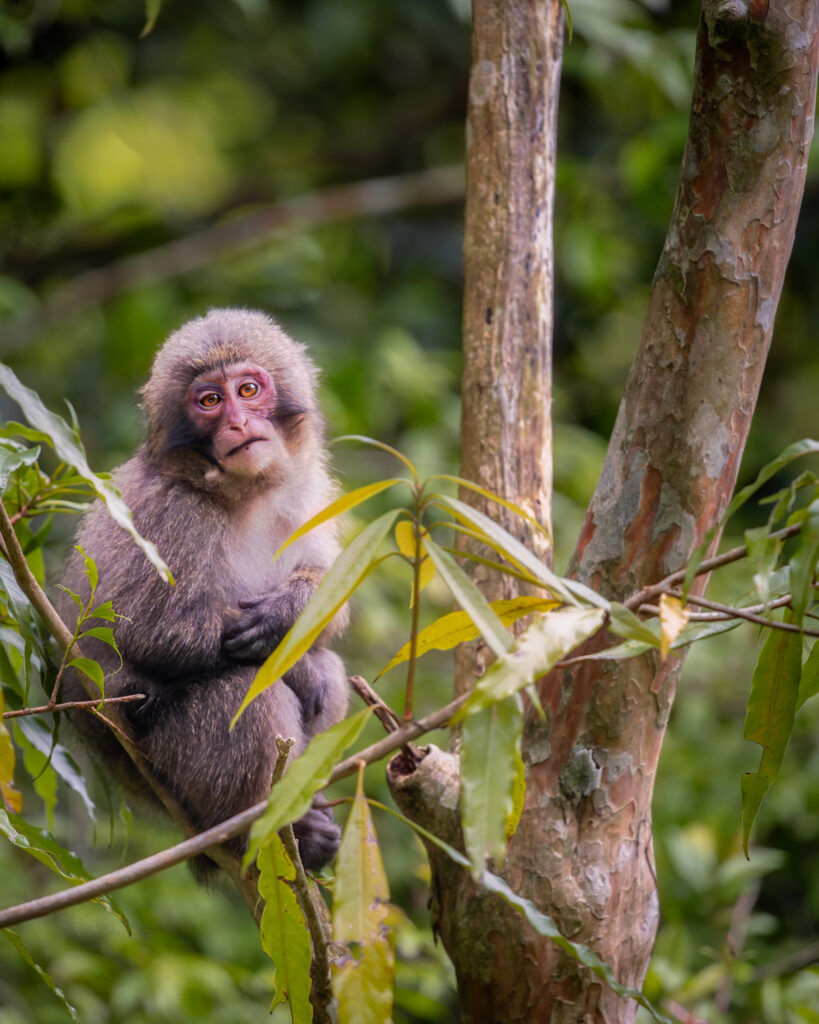
Between the monkeys lounging in the trees, the deer grazing quietly in the undergrowth, and the jungle closing in around the road, it felt like something out of a nature film. A little unpredictable, a little wild—but definitely one of the most memorable parts of the trip.
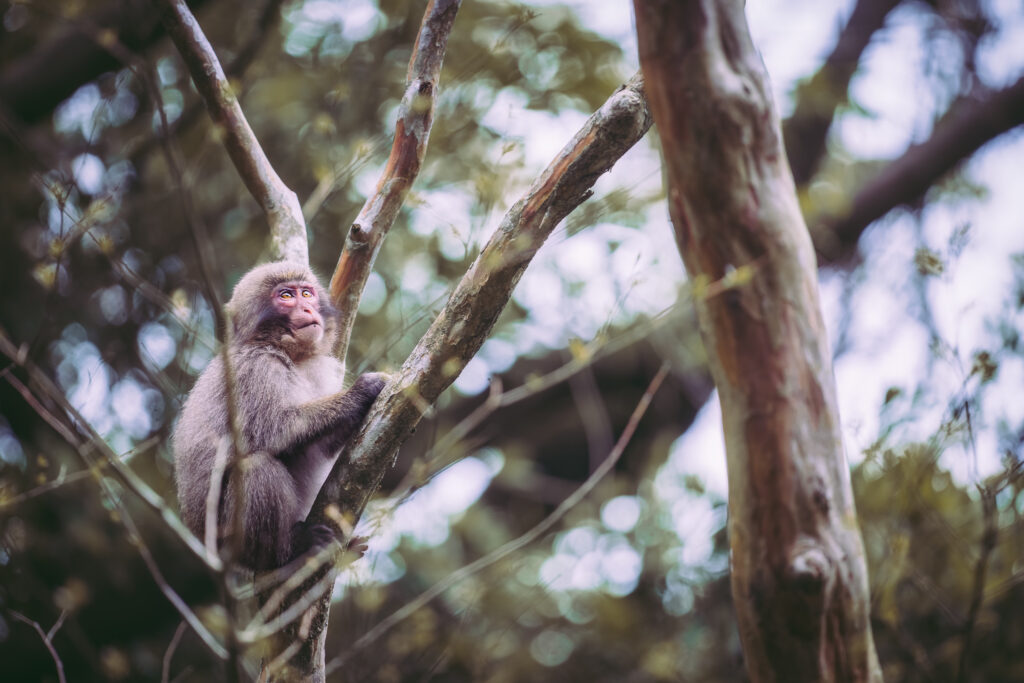
Yakusugi Land in the Rain
The next morning, it was raining—perfect conditions for photographing forests. Overcast skies or rain can create quiet, diffused light, cut down harsh contrast, and even bring mist into the trees, which is ideal for isolating shapes and creating atmosphere. Hoping for those kinds of conditions, I set off for Yakusugi Land—another protected area of ancient cedar forest, slightly more remote and typically less crowded than Shiratani Unsuikyo Ravine.

Yakusugi Land is home to some of the island’s most impressive Yakusugi trees, many of them over 1,000 years old, surrounded by dense moss, roots, and rich forest texture. It’s well maintained, with multiple walking courses ranging from short loops to longer climbs that take you deeper into the forest.
When I arrived, the rain had picked up—really heavy. I immediately regretted not buying the rain cover for my camera I’d meant to grab in Kagoshima. I had been too lazy to cross town and figured I’d be fine. Instead, I just hoped the weather sealing on the Z8 and Z 24–120mm would hold up, and promised myself not to change lenses while out.
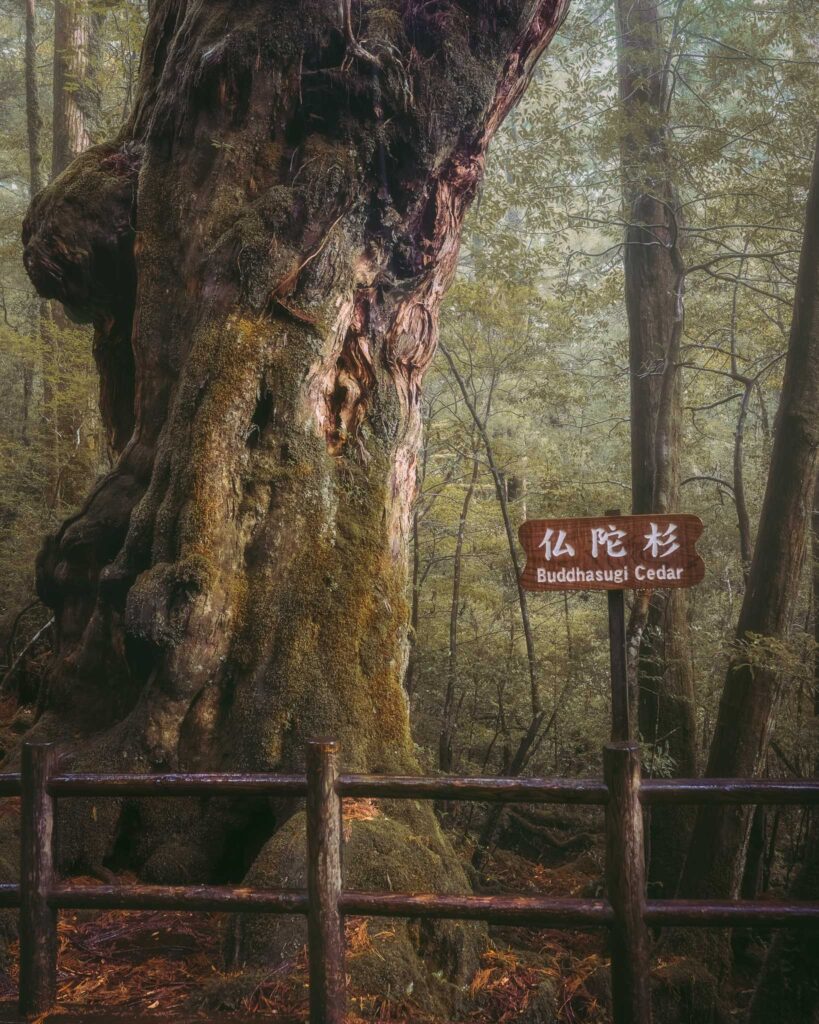
I threw on my rain gear, zipped everything tight, and headed into the forest. The light was so much better than the previous day—soft, even, and perfect for forest scenes. But within minutes, my camera was getting absolutely soaked. I was confident the sealing would handle it… but not confident enough to relax. So I dug out a small umbrella from my bag and used it to shield the camera as best I could.
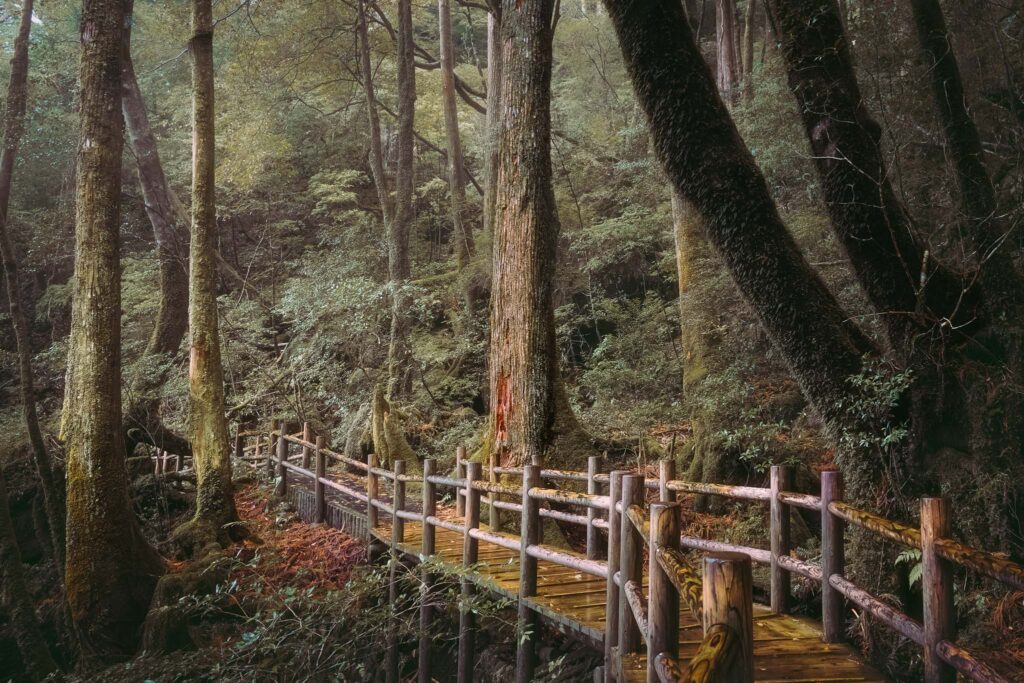
My original plan was to shoot with a tripod to keep ISO low and get cleaner files. The forest was dark, and slower shutter speeds were necessary. I set up a few shots like this—some nice compositions with old Yakusugi trees—but juggling a tripod, umbrella, and camera in pouring rain was way too much hassle. Eventually, I gave up on the tripod completely and committed to shooting handheld.
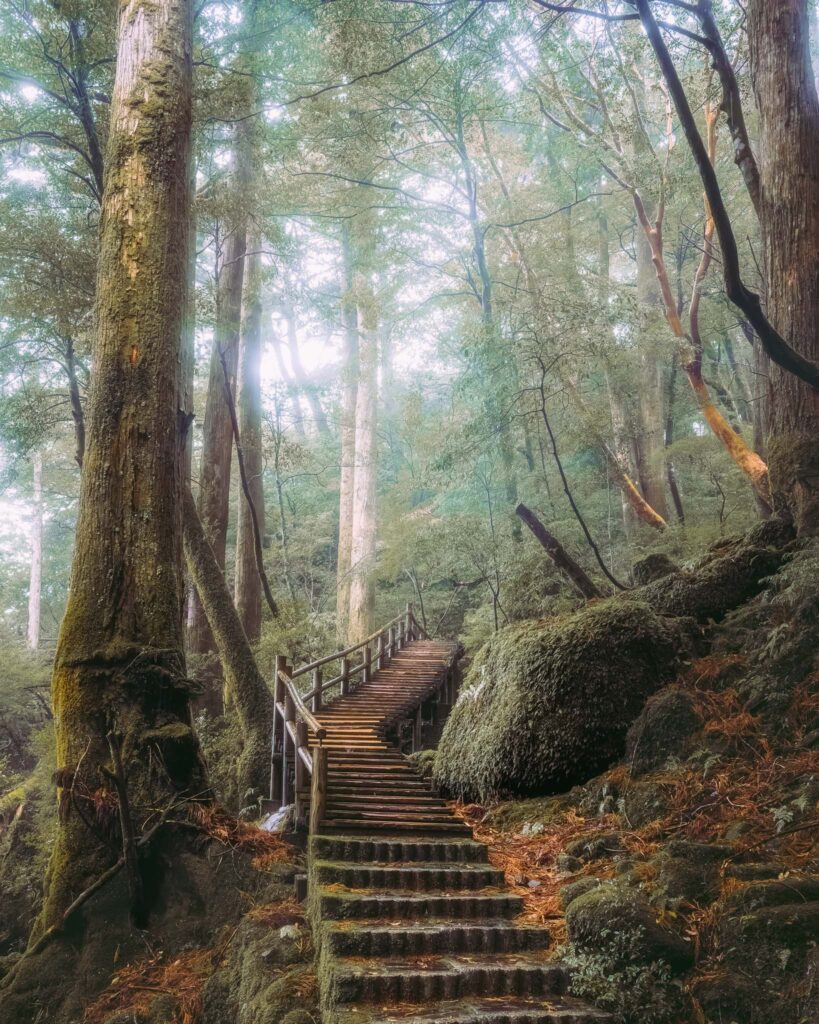
I switched to Auto ISO, adjusted shutter speed as slow as I could get away with (while balancing an umbrella awkwardly between my shoulder and neck), and just let the ISO climb as high as it needed. I spent 2–3 hours walking in the rain, completely soaked but loving the mood of the forest. I assumed most of the images would be shaky or noisy messes—but it felt worth trying anyway.
Eventually, I bailed out, worried about having the camera exposed to rain for so long—even with the umbrella, it was getting wet. I made it back to the car, dripping and cold, hoping at least a few images were usable.
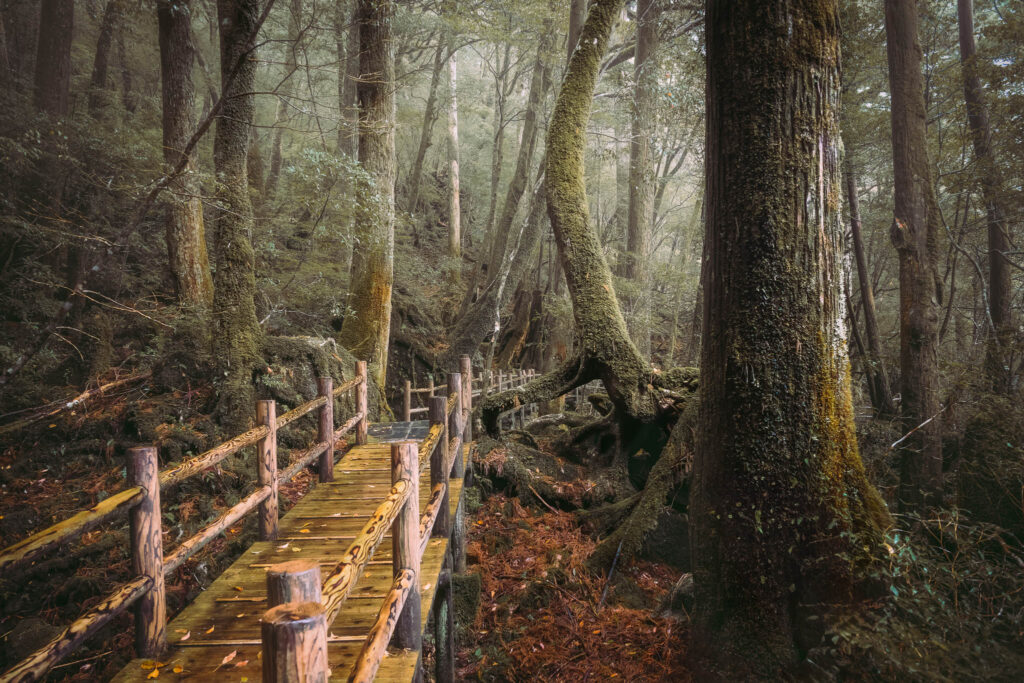
Back at my laptop, I was blown away. The IBIS on the Nikon Z8 and the stabilization in the 24–120mm had kept most of the shots shockingly sharp, even at shutter speeds I’d normally avoid handheld. I noticed some of the shots had pushed past ISO 10,000, which on my old cameras would’ve been unusable. Yes, there was visible noise—but after running everything through DXO PureRAW 5, the results looked seriously good. Clean, detailed, and way better than I expected.

With my older APS-C cameras, those photos would’ve fallen apart. But this time, despite the chaos and the conditions, some of my favorite images from Yakushima came out of this session—rain, high ISO, umbrella-balancing, and all.
Mt. Mocchomu-dake and the Search for Light
The next day, I decided to explore the southern side of the island, where I’d previously seen a mountain with a striking, clean rock face. I later found out it’s called Mt. Mocchomu-dake—a dramatic granite peak that rises sharply from the surrounding forest. It’s one of Yakushima’s most iconic mountains, despite being only 940 meters high, thanks to its steep cliffs and bold presence. I was keen to find a strong composition that featured it—something more open and structured after spending the last couple of days in dense, chaotic forest scenes.
I’d pinned two potential spots on Google Maps. The first was the well-known Torōki Waterfall—a rare waterfall that drops directly into the sea, framed by a red bridge with Mt. Mocchomu-dake in the background. The second was a little more off the beaten track: a small backroad bridge over a river, where I thought I might be able to use the river as a leading line toward the mountain.
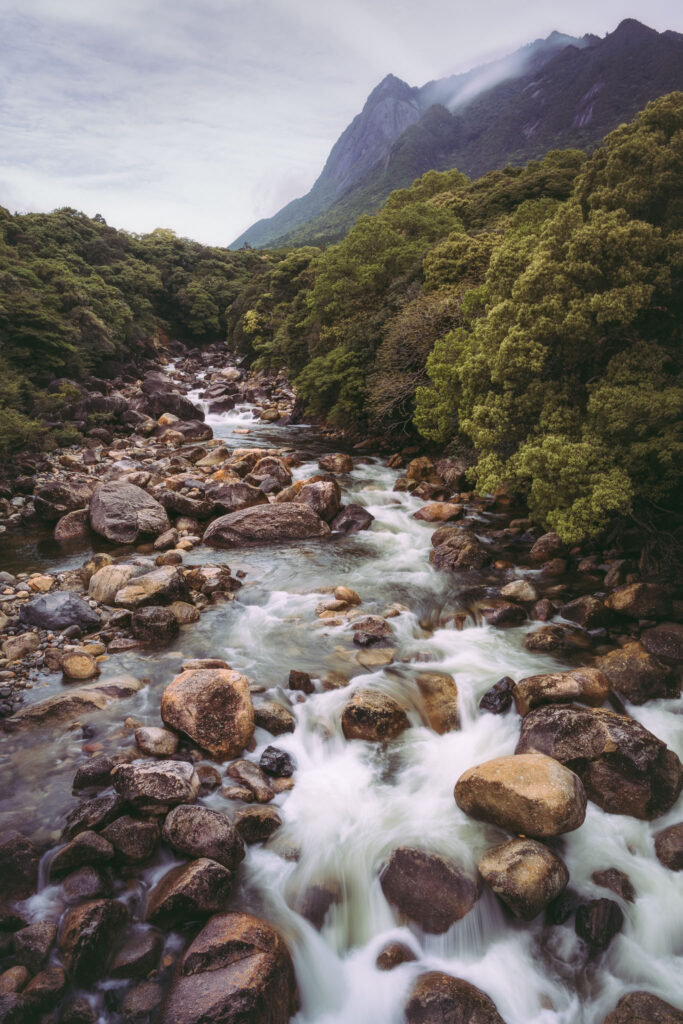
The weather forecast wasn’t ideal—low, thick cloud was expected in the morning, likely covering the mountain. But there was a chance it might lift later, so I decided to skip the early wake-up and head out at a more reasonable time. When I arrived, it was grey and overcast, but thankfully the mountain wasn’t completely obscured yet.
I went to the bridge location first. Standing on the bridge, I found that the side with the river flowing more directly underneath gave me the stronger angle. I set up and began experimenting with long exposures, using ND filters to blur the clouds as they moved across the mountain’s face. It created some nice streaking effects, but the light was flat, and the composition felt like it had potential—but not without better conditions. I waited for about an hour, hoping for a break in the clouds, but eventually decided to move on.
Next, I headed to Torōki Waterfall, only about 10 minutes away. From the carpark, it was a short forest walk to a viewing platform. The composition there is very limited—there’s really only one angle you can shoot from. I set up my tripod and tried to stay out of the way of the occasional tourists who came and went.
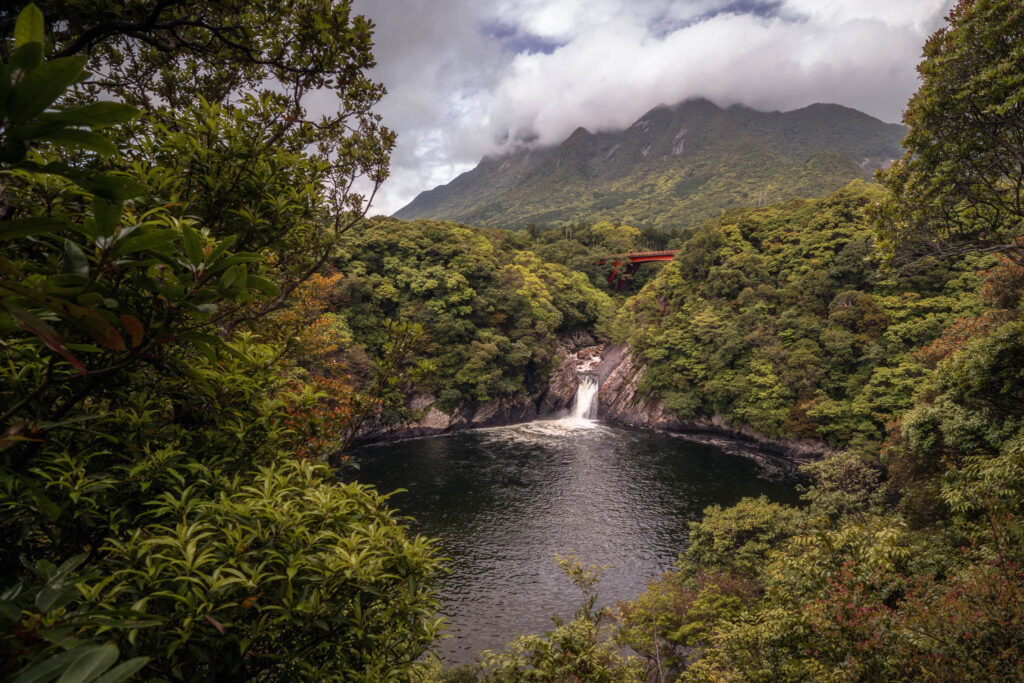
By the time I arrived, the clouds had dropped and Mt. Mocchomu-dake was mostly covered. I played around with shutter speed again, using ND filters to compare different looks for the waterfall. At the same time, I set up my DJI Pocket 3 to capture a timelapse in case the clouds lifted like the forecast had predicted.
It got close a few times—there were moments when the mountain almost revealed itself—but the light never quite broke through. I waited over two hours, hoping for a shaft of sunlight or a gap in the clouds, but it never happened. Still, the mood was peaceful, and I enjoyed being there.
While I waited, a few Japanese tourists stopped by—some curious, a few surprised to see a foreigner out here with all the gear set up. It turned into a good excuse to practice my sketchy Japanese, and even though the light never showed up, the conversations made the time pass in a nice way.
Conclusion
After a few days on the island, I returned to Kagoshima by ferry—soaked, memory cards full, and already thinking about how I’d do things differently next time.
Yakushima was everything I expected: wild, wet, and beautiful—but also more challenging than I anticipated. Composing in the dense forests was tough, and the weather didn’t always cooperate. But even when the light wasn’t ideal, there was always something to take in—the texture of moss, the weight of the rain, the presence of trees that have stood for over a thousand years.

I’m pretty happy with some of the images I came away with. One of the biggest surprises was just how well the Z8 handled extreme forest conditions—high ISO, slow shutter speeds, low light. I pushed the camera harder than I usually would, and it delivered. What I thought might be unusable turned out to be some of my favorite shots from the trip, especially after putting them through DXO PureRAW 5.
More than anything, I left feeling like I’d just scratched the surface. Now that I’ve seen how the island flows—how the trails connect, where the light falls, what the forest feels like in the rain—I’d love to come back and take my time. Spend longer with the Yakusugi cedars, wait out the weather, and return to the places that felt like they had more to give. Next time, I won’t feel the need to keep checking what’s around the next corner. I’ll already know. And I’ll be ready to slow down and go deeper.
